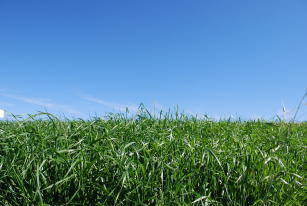Temperate forage grass breeding: Italian ryegrass and velvet grass (Yorkshire fog)
Temperate forage grass breeding: Italian ryegrass and velvet grass (Yorkshire fog)

Photo: MAGNANTE, Luiz Henrique
The cultivation of winter forage crops such as Italian ryegrass ( Lolium multiflorum) and velvet grass ( Holcus lanatus) is of extreme importance for increasing the productivity and efficiency of livestock production in the South Region and part of the Southeast Region of Brazil. However, there are few cultivars for use by farmers. The problem focused in this project is the lack of improved cultivars of temperate forage grasses, productive and adapted to the Brazilian conditions. Thus, this project aims to obtain and release cultivars of these two important grasses. Specific objectives include maintaining Embrapa’s Italian ryegrass and velvet grass germplasm stocks, studying the existing genetic variability and extending it through the formation of compounds and chromosome duplication; obtaining new Italian ryegrass and velvet grass cultivars through evaluation and selection; evaluating the interaction of forage grass populations with potentially beneficial microorganisms; obtaining the data for registration and protection of cultivars, in accordance with current legislation;evaluating the stability and genetic purity of improved Italian ryegrass populations by means of molecular markers; transferring and promoting the adoption of technologies generated by validation under different soil and climatic conditions and production systems, besides disseminating it in a way accessible the different segments of the public; and releasing the Italian ryegrass and velvet grass cultivars obtained in the previous phases of the current breeding program. The main result obtained until the moment was the launch, in August 2017, of the Italian ryegrass cultivar BRS Integração. The other expected results are the obtaining of at least one cultivar of each studied species and advancement of knowledge with the study of fragile sites in Lolium and the evaluation of the stability and genetic purity of the cultivars throughout the production phases and seeds. And from the methodological point of view, a panel of markers is being developed to monitor the stability and genetic purity of the cultivars. Positive impacts are expected in the milk and meat production chain, as well as in the forage seed production chain. The expected impacts are an increase in livestock productivity, through the use of pastures with higher production of quality forage; a reduction in costs by replacing other more costly feeds and also in risks, by farmers acquiring quality seeds; and a reduction the seasonality of forage production, since it will be possible to offer the animals quality feed during the cold season, and as well minimizing the lack of forage availability during the autumn and spring. Positive environmental impacts are expected in terms of systems sustainability, with improved soil and vegetation conservation in natural fields. The impact of the results should cover the entire South Region and part of the Southeast Region of Brazil.
Ecosystem: Extreme South, Atlantic Forest, Pinheirais Region
Status: Completed Start date: Fri Apr 01 00:00:00 GMT-03:00 2016 Conclusion date: Tue Mar 31 00:00:00 GMT-03:00 2020
Head Unit: Embrapa Dairy Cattle
Project leader: Andrea Mittelmann
Contact: andrea.mittelmann@embrapa.br
Keywords: Lolium multiflorum, Holcus lanatus, cultivares, produtividade, poliploidização
